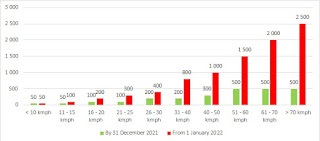The most impressive flop of early 2022 is definitely the overwhelming mess subsequent to the rollout of the Nowy Ład. What goes on around the new tax legislation is a topic for a separate posting, yet today I refuse to have my nerves frayed by it. It is no secret I am not a beneficiary of it, yet I would agree to pay higher taxes, provided the tax law is simplified and tax proceeds and spent wisely. Sadly, neither the latter not the former holds true for Poland.
But wallets of motorists might be hit not only by higher taxes and other contributions, but also by fines for violations of the highway code. The penalty rates in Poland had not been revised since late 1990s and were laughably low in comparison to other countries. The fine rates for speeding, the most common offence on Polish roads have been revised upward, as shown on the chart. The lawmakers have turned out to be lenient for minor speeding, yet the higher the deviation of the actual speed from the limit, the more severity of the punishment increases. The point beyond speeding gets painfully expensive is 30 kmph. Besides, there is no flat fine for speeding above 50 kpmh, but fine amounts rise along with the scale of offence (or rather crime, given somebody driving 120 kmph in town where the speed limit is 50 kmph is already a criminal).
The upshot is that on the New Year’s Day Polish roads got similar to what I witness abroad. When venturing beyond the border of Poland I was always careful not to exceed speed limit, so that my holiday budgets were spared costly fines. Poles have been legendarily obedient abroad and careless in their homeland. Today it has changed for the majority of drivers, but I still see reckless idiots, usually in quite new premium-make oversized vehicles who do not give a damn about the higher fines. Nevertheless, the general tendency bears out a financial punishment serves best as a disincentive to commit offences.
Another change mentioned by some experts which should follow is the verification of speed limits on specific roads. I have no idea why the stretch of ul. Puławska along Wyścigi, with merely one intersection and no pedestrians crossing has lower speed limit (50 kmph) than the section between ul. Poleczki and the boundary of the city, where the speed limit is 60 kmph. I hold the view there are thoroughfares in Warsaw where speed limits could be increased by 10 or even 20 kmph, while traffic on minor roads should be calmed, as 50 kmph is far too much for several narrow streets.
Other pricing reshuffles which are taking place in early 2022 are:
- the increase in long-distance train ticket prices,
- the decrease in excise tax for fuel,
which given the effort to reduce carbon dioxide emissions, work the opposite
way round than they should.
I have taken the trouble to compare a cost of a business trip taken in 11 days (planned yesterday for 2 February) for a six-hour workshop (which cannot be held online) in another bigger city (I have chosen 4 which have decent train connections to Warsaw – Poznań, Wrocław, Kraków and Gdańsk).
My assumptions:
- my destination is located 1 kilometre from a main train station so that I can
walk there,
- start time of the workshop can be adjusted to match the train timetable,
- by car I drive door to door and pay a parking charge of 30 PLN in each city,
- I travel on my own,
- the cost of fuel is based on petrol price of 5.10 PLN per litre (envisaged
after the excise tax cut) and the average consumption of petrol is 7.0 litres
per 100 kilometres – this gives 0.357 PLN per kilometre,
- since I have no travelcard, I need to buy two 75-minute tickets each to get
to W-wa Centralna Station,
- I travel in second class by train,
- on my way to Poznań I pay motorway charges, to Gdańsk I take S7 expressway,
- the cost of car journey increases by the cost of accelerated depreciation and
higher upkeep costs on account of higher mileage – 0.10 PLN per kilometre
- journey time by car to each destination is calculated with Google Maps
(mid-time for bracket) with 30 minutes added each way,
- I need to set off to the train station 55 minutes before train departure and
return home 45 minutes after train arrival
Here come the results (cost and journey duration):

I am positively surprised by the outcomes, especially with respect to the journey duration. But note with 2 passengers the journey by car gets cheaper. Is the proportion right?





No comments:
Post a Comment